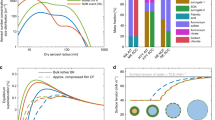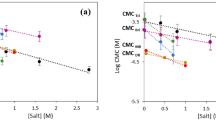Abstract
The spontaneous growth of cloud condensation nuclei (CCN) into cloud droplets under supersaturated water vapour conditions is described by classic Köhler theory1,2. This spontaneous activation of CCN depends on the interplay between the Raoult effect, whereby activation potential increases with decreasing water activity or increasing solute concentration, and the Kelvin effect, whereby activation potential decreases with decreasing droplet size or increases with decreasing surface tension, which is sensitive to surfactants1. Surface tension lowering caused by organic surfactants, which diminishes the Kelvin effect, is expected to be negated by a concomitant reduction in the Raoult effect, driven by the displacement of surfactant molecules from the droplet bulk to the droplet–vapour interface3,4. Here we present observational and theoretical evidence illustrating that, in ambient air, surface tension lowering can prevail over the reduction in the Raoult effect, leading to substantial increases in cloud droplet concentrations. We suggest that consideration of liquid–liquid phase separation, leading to complete or partial engulfing of a hygroscopic particle core by a hydrophobic organic-rich phase, can explain the lack of concomitant reduction of the Raoult effect, while maintaining substantial lowering of surface tension, even for partial surface coverage. Apart from the importance of particle size and composition in droplet activation, we show by observation and modelling that incorporation of phase-separation effects into activation thermodynamics can lead to a CCN number concentration that is up to ten times what is predicted by climate models, changing the properties of clouds. An adequate representation of the CCN activation process is essential to the prediction of clouds in climate models, and given the effect of clouds on the Earth’s energy balance, improved prediction of aerosol–cloud–climate interactions is likely to result in improved assessments of future climate change.
This is a preview of subscription content, access via your institution
Access options
Access Nature and 54 other Nature Portfolio journals
Get Nature+, our best-value online-access subscription
$29.99 / 30 days
cancel any time
Subscribe to this journal
Receive 51 print issues and online access
$199.00 per year
only $3.90 per issue
Buy this article
- Purchase on Springer Link
- Instant access to full article PDF
Prices may be subject to local taxes which are calculated during checkout



Similar content being viewed by others
References
Köhler, H. The nucleus in and the growth of hygroscopic droplets. Trans. Faraday Soc. 32, 1152–1161 (1936)
McFiggans, G. et al. The effect of physical and chemical aerosol properties on warm cloud droplet activation. Atmos. Chem. Phys. 6, 2593–2649 (2006)
Sorjamaa, R. et al. The role of surfactants in Köhler theory reconsidered. Atmos. Chem. Phys. 4, 2107–2117 (2004)
Li, Z., Williams, A. L. & Rood, M. J. Influence of soluble surfactant properties on the activation of aerosol particles containing inorganic solute. J. Atmos. Sci. 55, 1859–1866 (1998)
Petters, M. D. & Kreidenweis, S. M. A single parameter representation of hygroscopic growth and cloud condensation nucleus activity. Atmos. Chem. Phys. 7, 1961–1971 (2007)
Ruehl, C. et al. Strong evidence of surface tension reduction in microscopic aqueous droplets. Geophys. Res. Lett. 39, L23801 (2012)
Ruehl, C. R., Davies, J. F. & Wilson, K. R. An interfacial mechanism for cloud droplet formation on organic aerosols. Science 351, 1447–1450 (2016)
Nozière, B., Baduel, C. & Jaffrezo, J.-L. The dynamic surface tension of atmospheric aerosol surfactants reveals new aspects of cloud activation. Nat. Commun. 5, 3335 (2014)
Sun, J. & Ariya, P. A. Atmospheric organic and bio-aerosols as cloud condensation nuclei (CCN): a review. Atmos. Environ. 40, 795–820 (2006)
Hallquist, M. et al. The formation, properties and impact of secondary organic aerosol: current and emerging issues. Atmos. Chem. Phys. 9, 5155–5236 (2009)
Liu, X. & Wang, J. How important is organic aerosol hygroscopicity to aerosol indirect forcing? Environ. Res. Lett. 5, 044010 (2010)
Ovadnevaite, J. et al. Primary marine organic aerosol: a dichotomy of low hygroscopicity and high CCN activity. Geophys. Res. Lett. 38, L21806 (2011)
Facchini, M. C., Decesari, S., Mircea, M., Fuzzi, S. & Loglio, G. Surface tension of atmospheric wet aerosol and cloud/fog droplets in relation to their organic carbon content and chemical composition. Atmos. Environ. 34, 4853–4857 (2000)
Sareen, N., Schwier, A. N., Lathem, T. L., Nenes, A. & McNeill, V. F. Surfactants from the gas phase may promote cloud droplet formation. Proc. Natl Acad. Sci. USA 110, 2723–2728 (2013)
Prisle, N. L. et al. Surfactant partitioning in cloud droplet activation: a study of C8, C10, C12 and C14 normal fatty acid sodium salts. Tellus B 60, 416–431 (2008)
Prisle, N. L., Raatikainen, T., Laaksonen, A. & Bilde, M. Surfactants in cloud droplet activation: mixed organic-inorganic particles. Atmos. Chem. Phys. 10, 5663–5683 (2010)
Ruehl, C. R. & Wilson, K. R. Surface organic monolayers control the hygroscopic growth of submicrometer particles at high relative humidity. J. Phys. Chem. A 118, 3952–3966 (2014)
Monahan, C ., Vuollekoski, H ., Kulmala, M & O’Dowd, C. Simulating marine new particle formation and growth using the M7 modal aerosol dynamics modal. Adv. Meteorol. http://dx.doi.org/10.1155/2010/689763 (2010)
Kleefeld, C. et al. Relative contribution of submicron and supermicron particles to aerosol light scattering in the marine boundary layer. J. Geophys. Res. Atmos. 107 (D19), 8103 (2002)
O’Dowd, C. et al. Do anthropogenic, continental or coastal aerosol sources impact on a marine aerosol signature at Mace Head? Atmos. Chem. Phys. 14, 10687–10704 (2014)
Rinaldi, M. et al. On the representativeness of coastal aerosol studies to open ocean studies: Mace Head—a case study. Atmos. Chem. Phys. 9, 9635–9646 (2009)
DeCarlo, P. F. et al. Field-deployable, high-resolution, time-of-flight aerosol mass spectrometer. Anal. Chem. 78, 8281–8289 (2006)
McLafferty, F. W & Turecek, F. Interpretation of Mass Spectra 4th edn (University Science Books, 1993)
Roberts, G. C. & Nenes, A. A continuous-flow streamwise thermal-gradient CCN chamber for atmospheric measurements. Aerosol Sci. Technol. 39, 206–221 (2005)
Vargaftik, N. B., Volkov, B. N. & Voljak, L. D. International tables of the surface tension of water. J. Phys. Chem. Ref. Data 12, 817–820 (1983)
Bialek, J., Dall’Osto, M., Monahan, C., Beddows, D. & O’Dowd, C. On the contribution of organics to the North East Atlantic aerosol number concentration. Environ. Res. Lett. 7, 044013 (2012)
Gérard, V . et al. Anionic, cationic, and nonionic surfactants in atmospheric aerosols from the Baltic coast at Askö, Sweden: implications for cloud droplet activation. Environ. Sci. Technol. 50, 2974–2982 (2016)
Sorjamaa, R. & Laaksonen, A. The influence of surfactant properties on critical supersaturations of cloud condensation nuclei. J. Aerosol Sci. 37, 1730–1736 (2006)
Zuend, A., Marcolli, C., Luo, B. P. & Peter, T. A thermodynamic model of mixed organic-inorganic aerosols to predict activity coefficients. Atmos. Chem. Phys. 8, 4559–4593 (2008)
Zuend, A. et al. New and extended parameterization of the thermodynamic model AIOMFAC: calculation of activity coefficients for organic-inorganic mixtures containing carboxyl, hydroxyl, carbonyl, ether, ester, alkenyl, alkyl, and aromatic functional groups. Atmos. Chem. Phys. 11, 9155–9206 (2011)
Song, M., Marcolli, C., Krieger, K. U., Lienhard, D. & Peter, T. Morphologies of mixed organic/inorganic/aqueous aerosol droplets. Faraday Discuss. 165, 289–316 (2013)
Acknowledgements
The research leading to these results received funding from the European Union’s Seventh Framework Programme (FP7/2007-2013) project BACCHUS under grant agreement number 603445, the Irish Environmental Protection Agency, the HEA PRTLI4 project and the Academy of Finland Center of Excellence programme (grant number 272041). The work was further supported by the CNR (Italy) under AirSEaLab: Progetto Laboratori Congiunti, the US Office of Naval Research, and the Natural Sciences and Engineering Research Council of Canada (NSERC, grant RGPIN/04315-2014). N.H. was supported by a National Science Foundation Atmospheric and Geospace Sciences Postdoctoral Research Fellowship (award number 14433246).
Author information
Authors and Affiliations
Contributions
J.O. conducted and analysed the AMS measurements and led the scientific development (in conjunction with C.O’D.). D.C. organized and conducted the aerosol measurements. G.R. and K.J.S. conducted the CCN measurements. M.C.F., S.D. and M.R. provided surface tension measurements. A.L. provided the partitioning model. A.Z. did the thermodynamic modelling. C.O’D., J.O., N.H., A.Z. and J.H.S. wrote the paper.
Corresponding author
Ethics declarations
Competing interests
The authors declare no competing financial interests.
Additional information
Reviewer Information Nature thanks M. Gysel, K. Wilson and the other anonymous reviewer(s) for their contribution to the peer review of this work.
Publisher's note: Springer Nature remains neutral with regard to jurisdictional claims in published maps and institutional affiliations.
Supplementary information
Supplementary Information
This file contains Supplementary Text and Data, Supplementary Figures, Supplementary Tables and Supplementary References. (PDF 10845 kb)
Rights and permissions
About this article
Cite this article
Ovadnevaite, J., Zuend, A., Laaksonen, A. et al. Surface tension prevails over solute effect in organic-influenced cloud droplet activation. Nature 546, 637–641 (2017). https://doi.org/10.1038/nature22806
Received:
Accepted:
Published:
Issue Date:
DOI: https://doi.org/10.1038/nature22806
This article is cited by
-
Multi-campaign ship and aircraft observations of marine cloud condensation nuclei and droplet concentrations
Scientific Data (2023)
-
Sea-spray regulates sulfate cloud droplet activation over oceans
npj Climate and Atmospheric Science (2020)
-
Lifecycle of light-absorbing carbonaceous aerosols in the atmosphere
npj Climate and Atmospheric Science (2020)
-
A Review on Laboratory Studies and Field Measurements of Atmospheric Organic Aerosol Hygroscopicity and Its Parameterization Based on Oxidation Levels
Current Pollution Reports (2020)
-
Model for estimating activity coefficients in binary and ternary ionic surfactant solutions
Journal of Atmospheric Chemistry (2020)
Comments
By submitting a comment you agree to abide by our Terms and Community Guidelines. If you find something abusive or that does not comply with our terms or guidelines please flag it as inappropriate.



